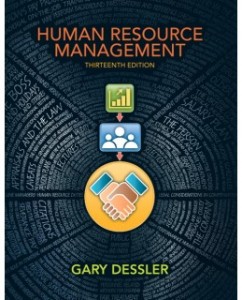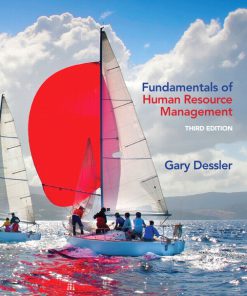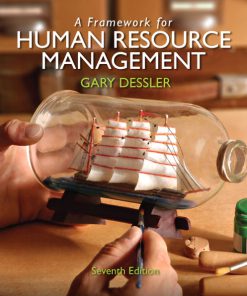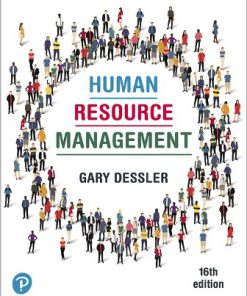Test Bank for Human Resource Management, 13th Edition: Gary Dessler
$35.00 Original price was: $35.00.$26.50Current price is: $26.50.
Test Bank for Human Resource Management, 13th Edition: Gary Dessler
This is completed downloadable of Test Bank for Human Resource Management, 13th Edition: Gary Dessler

Product Details:
- ISBN-10 : 0132668211
- ISBN-13 : 978-0132668217
- Author: Gary Dessler
Authoritative and current information on Human Resource Management that ALL managers can use.
This best-selling HRM text is designed to provide authoritative and accurate information on HR-related responsibilities and personnel management by focusing on practical applications, concepts, and techniques that ALL managers can use in business.
More than 100 new topics can be found throughout this edition, along with new features and video cases.
Table of Content:
Contents Preface 00 Acknowledgments 00 Part 1 Introduction 1 Chapter 1 Introduction to Human Resource Management 1 Human Resource Management at Work 2 What Is Human Resource Management? 2 Why Is Human Resource Management Important to All Managers? 3 Line and Staff Aspects of Human Resource Management 3 Line Managers' Human Resource Duties 4 Human Resource Manager's Duties 4 Cooperative Line and Staff HR Management: An Example 5 From Line Manager to HR Manager 7 The Changing Environment of Human Resource Management 8 Globalization Trends 8 Technological Trends 10 Trends in the Nature of Work 10 Workforce Demographic Trends 11 The Changing Role of Human Resource Management 12 Strategic Human Resource Management 12 Creating High-Performance Work Systems 13 Measuring the Human Resource Management Team's Performance 15 Managing with the HR Scorecard Process 17 The Human Resource Manager's Proficiencies 17 Four Proficiencies 17 HR Certification 18 Managing within the Law 18 Managing Ethics 20 The Plan of this Book 20 The Basic Themes and Features 20 Chapter Contents Overview 21 Part 1: Introduction 21 Part 2: Recruitment and Placement 21 Part 3: Training and Development 22 Part 4: Compensation 22 Part 5: Employee Relations 22 The Topics Are Interrelated 22 Summary 23 Discussion Questions 24 Individual and Group Activities 24 Experiential Exercise 25 Application Case 25 Continuing Case 26 Chapter 2 Equal Opportunity and the Law 31 Equal Employment Opportunity 1964-1991 32 Title VII of the 1964 Civil Rights Act 32 Executive Orders 33 Equal Pay Act of 1963 33 Age Discrimination in Employment Act of 1967 33 Vocational Rehabilitation Act of 1973 33 Pregnancy Discrimination Act of 1978 33 Federal Agency Guidelines 34 Early Court Decisions Regarding Equal Employment Opportunity 34 Equal Employment Opportunity 1990-91-Present 35 The Civil Rights Act of 1991 35 The Americans with Disabilities Act 36 State and Local Equal Employment Opportunity Laws 41 Sexual Harassment 41 n The New Workforce: Enforcing Equal Employment Laws with #nternational Employees 47 Defenses Against Discrimination Allegations 48 Adverse Impact 49 Bona Fide Occupational Qualification 50 Business Necessity 51 Other Considerations in Discriminatory Practice Defenses 52 Illustrative Discriminatory Employment Practices 52 A Note on What You Can and Cannot Do 52 Recruitment 53 Selection Standards 53 Sample Discriminatory Promotion, Transfer, and Layoff Practices 54 The Eeoc Enforcement Process 55 Voluntary Mediation 57 Mandatory Arbitration of Discrimination Claims 58 Management Guidelines for Addressing EEOC Claims 58 Diversity Management and Affirmative Action Programs 60 n When Your's on Your Own: Dealing with Discrimination Issues and the EEOC 60 Managing Diversity 61 Workforce Diversity in Practice 62 Diversity's Benefits 62 Equal Employment Opportunity Versus Affirmative Action 63 Steps in an Affirmative Action Program 63 n Improving Productivity Through HRIS: Measuring Diversity 64 Recruiting Minorities Online 64 Reverse Discrimination 64 Summary 65 Discussion Questions 65 Individual and Group Activities 67 Experiential Exercise 67 Application Case 68 Continuing Case 69 Chapter 3 Strategic Human Resource Management and the #R Scorecard 77 The Strategic Management Process 78 Steps in Strategic Management 78 Types of Strategies 82 Achieving Strategic Fit 83 n When Your's on Your Own: Using Computerized Business Planning Software 83 Human Resource Management's Role in Creating Competitive Advantage 85 n The New Workforce: Longo Toyota 85 Strategic Human Resource Management 86 Strategic Human Resource Challenges 87 Human Resource Management's Strategic Roles 88 The Strategy Execution Role 89 The Strategy Formulation Role 90 Creating the Strategic Human Resource Management System 91 The High-Performance Work System 92 Translating Strategy into Human Resource Policy and Practice 94 Translating Strategy into Human ResourcePolicies and Practices: An Example 95 Summary 97 Discussion Questions 98 Individual and Group Activities 98 Experiential Exercise 99 Application Case 99 Continuing Case 100 Part 2 Recruitment and Placement 125 Chapter 4 Job Analysis 125 The Basics of Job Analysis 126 Uses of Job Analysis Information 126 Steps in Job Analysis 127 Methods for Collecting Job Analysis Information 129 Some Job Analysis Guidelines 129 The Interview 129 Questionnaires 133 Observation 133 Participant Diary/Logs 136 Quantitative Job Analysis Techniques 137 Internet-Based Job Analysis 140 A Final Point: Use Multiple Sources to Collect the Data 140 Writing Job Descriptions 141 Job Identification 144 Job Summary 144 Relationships 145 Responsibilities and Duties 145 Standards of Performance and Working Conditions 145 Duty: Accurately Posting Accounts Payable 146 n Know Your Employment Law: Writing Job Descriptions That Comply #ith the ADA 146 Duty: Meeting Daily Production Schedule 147 Using the Internet for Writing Job Descriptions 147 Writing Job Specifications 148 Specifications for Trained Versus Untrained Personnel 148 Specifications Based on Judgment 148 n When Your's on Your Own: Using O*NET 150 Job Specifications Based on Statistical Analysis 153 Job Analysis in a "Jobless" World 153 A (Very) Brief History: From Specialized to Enlarged Jobs 153 Why Managers Are "Dejobbing" Their Companies 154 n The New Workforce: Global Job Analysis Applications 154 Competency-Based Job Analysis 155 An Example: BP's Matrices 158 Summary 159 Discussion Questions 159 Individual and Group Activities 160 Experiential Exercise 160 Application Case 161 Continuing Case 161 Chapter 5 Personnel Planning and Recruiting 165 The Recruitment and Selection Process 166 Planning and Forecasting 166 Forecasting Personnel Needs 167 Forecasting the Supply of Inside Candidates 169 Forecasting the Supply of Outside Candidates 171 Effective Recruiting 172 Why Recruiting Is Important 172 Recruiting's Complexities 172 n Know Your Employment Law: Preemployment Activities 173 Organizing the Recruitment Function 174 Measuring Recruiting Effectiveness 174 The Recruiting Yield Pyramid 176 Internal Sources of Candidates 176 Internal Sources: Pros and Cons 176 Finding Internal Candidates 177 Rehiring 177 Succession Planning 177 Improving Productivity Through HRIS: Succession Planning Systems 178 Outside Sources of Candidates 178 Recruiting via the Internet 178 Advertising 182 Employment Agencies 183 Temp Agencies and Alternative Staffing 185 Offshoring/Outsourcing White-Collar and Other Jobs 186 n Know Your Employment Law: Contingent Workers 187 Executive Recruiters 188 n When Your's on Your Own: Recruiting 101 189 On Demand Recruiting Services 190 College Recruiting 190 Referrals and Walk-Ins 191 Recruiting Source Use and Effectiveness 192 Improved Productivity Through HRIS: An Integrated Technology Approach to Recruiting 194 Recruiting a More Diverse Workforce 194 Single Parents 194 Older Workers 195 Recruiting Minorities and Women 195 n The New Workforce: Supervising Older Workers 196 Welfare-to-Work 197 The Disabled 197 Developing and Using Application Forms 197 Purpose of Application Forms 197 Application Forms and the Law 198 Using Application Forms to Predict Job Performance 200 n Know Your Employment Law: Mandatory Arbitration 200 Summary 200 Discussion Questions 201 Individual and Group Activities 201 Experiential Exercise 202 Application Case 202 Continuing Case 203 Chapter 6 Employee Testing and Selection 209 Why Careful Selection is Important 210 Basic Testing Concepts 211 Reliability 211 Validity 211 How to Validate a Test 213 Test Takers' Individual Rights and Test Security 216 n Know Your Employment Law: Equal Employment Opportunity Aspects of Testing 217 Using Tests at Work 218 n The New Workforce: Gender Issues in Testing 219 Computerized and Online Testing 220 Types of Tests 221 Tests of Cognitive Abilities 221 Tests of Motor and Physical Abilities 222 Measuring Personality and Interests 222 Achievement Tests 224 Work Samples and Simulations 224 Work Sampling for Employee Selection 225 Management Assessment Centers 225 Video-Based Situational Testing 226 The Miniature Job Training and Evaluation Approach 227 Realistic Job Previews 228 n When Your's on Your Own: Employee Testing and Selection 228 Summary 229 Background Investigations and Other Selection Methods 229 Background Investigations and Reference Checks 229 Using Preemployment Information Services 234 The Polygraph and Honesty Testing 235 Graphology 238 Physical Exams 238 Substance Abuse Screening 238 Complying with Immigration Law 240 n Improving Productivity Through HRIS: Comprehensive Automated Applicant #racking and Screening Systems 241 Summary 242 Discussion Questions 242 Individual and Group Activities 243 Experiential Exercise 243 Application Case 244 Continuing Case 245 Chapter 7 Interviewing Candidates 253 Basic Features of Interviews 254 Types of Interviews 254 Structured Versus Unstructured Interviews 254 n Know Your Employment Law: Interviewing Candidates 255 Administering the Interview 259 Computerized Interviews 260 Are Interviews Useful? 262 What Can Undermine an Interview's Usefulness? 262 First Impressions (Snap Judgments) 262 Misunderstanding the Job 263 Candidate-Order (Contrast) Error and Pressure to Hire 263 Nonverbal Behavior and Impression Management 264 Effect of Personal Characteristics: Attractiveness, Gender, Race 264 n The New Workforce: Applicant Disability and the Employment Interview 265 Interviewer Behavior 266 Designing and Conducting an Effective Interview 266 The Structured Situational Interview 266 How to Conduct a More Effective Interview 268 n When Your's on Your Own: Employment Interviewing91 272 Summary 275 Discussion Questions 275 Individual and Group Activities 276 Experiential Exercise 277 Application Case 277 Continuing Case 278 Part 3 Training and Development 291 Chapter 8 Training and Developing Employees 291 Orienting Employees 292 Purpose of Orientation 292 The Orientation Process 292 The Training Process 294 Training's Strategic Context 294 The Five-Step Training and Development Process 295 Training, Learning, and Motivation 296 Motivation Principles for Trainers 296 Analyzing Training Needs 297 n Know Your Employment Law: Training and the Law 297 Task Analysis: Assessing New Employees' Training Needs 298 Performance Analysis: Assessing Current Employees' Training Needs 298 Training Methods 300 On-the-Job Training 300 Apprenticeship Training 301 Informal Learning 302 Job Instruction Training 302 Lectures 303 Programmed Learning 303 Audiovisual-Based Training 304 Simulated Training 304 Computer-Based Training 304 Electronic Performance Support Systems (EPSS) 306 Distance and Internet-Based Training 306 Internet-Based Training 307 Using E-Learning 308 n Improving Productivity Through HRIS: Learning Portals 309 Literacy Training Techniques 309 Management Development 310 n The New Workforce: Diversity Training 310 Managerial On-the-Job Training 311 Off-the-Job Management Training and Development Techniques 312 n When Your's on Your Own: Creating Your Own Training Program 314 Managing Organizational Change and Development 316 What to Change 316 Overcoming Resistance to Change: Lewin's Change Process 317 How to Lead the Change 318 Using Organizational Development 319 Evaluating the Training Effort 321 Designing the Study 321 Training Effects to Measure 322 Summary 324 Discussion Questions 324 Individual and Group Activities 325 Experiential Exercise 326 Application Case 326 Continuing Case 327 Chapter 9 Performance Management and Appraisal 335 Basic Concepts in Performance Management and Appraisal 336 Comparing Performance Appraisal and Performance Management 336 Why Performance Management? 336 Defining the Employee's Goals and Work Standards 338 An Introduction to Appraising Performance 339 Why Appraise Performance? 339 Realistic Appraisals 340 The Supervisor's Role 340 Steps in Appraising Performance 340 Graphic Rating Scale Method 341 n The New Workforce: Performance Appraisals and Joint Venture Collaboration 341 Alternation Ranking Method 344 Paired Comparison Method 344 Forced Distribution Method 345 Critical Incident Method 348 Narrative Forms 350 Behaviorally Anchored Rating Scales 350 Management by Objectives 353 Computerized and Web-Based Performance Appraisal 354 Merging the Methods 355 Appraising Performance: Problems and Solutions 355 Potential Rating Scale Appraisal Problems 355 How to Avoid Appraisal Problems 357 Who Should Do the Appraising? 359 n Know Your Employment Law: Appraising Performance 360 The Appraisal Interview 362 Types of Appraisal Interviews 363 How to Conduct the Appraisal Interview 364 Appraisals in Practice 366 Creating the Total Performance Management Process 366 Improving Productivity Through 366 Summary 367 Discussion Questions 368 Individual and Group Activities 369 Experiential Exercise 369 Application Case 369 Continuing Case 371 Chapter 10 Managing Careers 377 The Basics of Career Management 378 Careers Today 378 Career Development Today 379 Roles in Career Planning and Development 380 The Employee's Role 380 The Employer's Role 382 n When Your's on Your Own: Employee Career Development 383 Innovative Corporate Career Development Initiatives 385 n Improving Productivity Through HRIS: Career 387 Managing Promotions and Transfers 387 Making Promotion Decisions 387 Handling Transfers 389 Enhancing Diversity Through Career Management 389 Sources of Bias and Discrimination in Promotion Decisions 389 Taking Steps to Enhance Diversity: Women's and Minorities' #rospects 391 Career Management and Employee Commitment 392 The New Psychological Contract 392 Commitment-Oriented Career Development Efforts 393 Retirement 393 Summary 369 Discussion Questions 369 Individual and Group Activities 397 Experiential Exercise 397 Application Case 398 Continuing Case 399 Part 4 Compensation 421 Chapter 11 Establishing Strategic Pay Plans 421 Basic Factors in Determining Pay Rates 422 Legal Considerations in Compensation 422 Union Influences on Compensation Decisions 425 n Know Your Employment Law: Some Special Common Pay Applications 426 n The New Workforce: Globalization and Diversity: Compensating Expatriate #mployees 429 Equity and Its Impact on Pay Rates 430 Establishing Pay Rates 431 Step 1. The Salary Survey 431 Step 2. Job Evaluation 433 Step 3. Group Similar Jobs into Pay Grades 438 Step 4. Price Each Pay Grade-Wage Curves 438 Step 5. Fine-Tune Pay Rates 439 Pricing Managerial and Professional Jobs 441 Compensating Executives and Managers 441 n When Your's on Your Own: Developing a Workable Pay Plan 442 Compensating Professional Employees 444 Competency-Based Pay 445 Introduction 445 What Is Competency-Based Pay? 445 Why Use Competency-Based Pay? 446 Competency-Based Pay in Practice 447 Competency-Based Pay: Pros, Cons, and Results 447 Other Compensation Trends 448 Broadbanding 448 Comparable Worth 450 Board Oversight of Executive Pay 450 n Improving Productivity Through HRIS: Automating Compensation Administration 451 Summary 452 Discussion Questions 452 Individual and Group Activities 453 Experiential Exercise 454 Application Case 454 Continuing Case 455 Chapter 12 Pay for Performance and Financial Incentives 471 Money and Motivation: An Introduction 472 Performance and Pay 472 Motivation and Incentives 473 Incentive Pay Terminology 474 Individual Employee Incentive and Recognition Programs 475 Piecework Plans 475 n Know Your Employment Law: Incentives 475 Merit Pay as an Incentive 476 Merit Pay Options 477 Incentives for Professional Employees 478 Recognition-Based Awards 478 Supporting Incentives and Recognition Programs with Technology 480 Incentives for Salespeople 480 Salary Plan 480 Commission Plan 481 Combination Plan 481 Setting Sales Quotas 482 Strategic Sales Incentives 483 Team/Group Incentive Plans 484 How to Design Team Incentives 484 Pros and Cons of Team Incentives 485 Organizationwide Incentive Plans 485 Profit-Sharing Plans 485 n When Your's on Your Own: Incentives Supervisors Can Use 486 Employee Stock Ownership Plan (ESOP) 487 Scanlon and Other Gainsharing Plans 487 Gainsharing Plans 488 At-Risk Variable Pay Plans 489 Incentives for Managers and Executives 489 Short-Term Incentives: The Annual Bonus 489 Long-Term Incentives 491 Other Executive Incentives 493 n The New Workforce: Long-Term Incentives for Overseas Executives 493 Strategy and Executive Compensation 494 Designing Effective Incentive Programs 494 Why Incentive Plans Fail 494 How to Implement Effective Incentive Plans 495 Research Insight: The Impact of Financial and Non-Financial Incentives 496 Incentive Plans in Practice: Nucor 497 Summary 498 Discussion Questions 498 Individual and Group Activities 499 Experiential Exercise 500 Application Case 501 Continuing Case 502 Chapter 13 Benefits and Services 509 The Benefits Picture Today 510 Pay for Time Not Worked 512 Unemployment Insurance 512 Vacations and Holidays 513 n Know Your Employment Law: Vacations and Holidays 514 Sick Leave 515 Parental Leave and the Family and Medical Leave Act 515 Severance Pay 519 Supplemental Unemployment Benefits 520 Insurance Benefits 520 Workers' Compensation 520 Hospitalization, Health, and Disability Insurance 521 Trends in Health Care Cost Control 523 n Know Your Employment Law: Health Care Benefits 524 Long-Term Care 526 Life Insurance 526 Benefits for Part-Time and Contingent Workers 526 Retirement Benefits 527 Social Security 527 Pension Plans 527 Pension Planning and the Law 529 Early Retirement 530 Phased Retirement and the Aging Workforce 531 n Improving Productivity Through HRIS: Benefits Management Systems 531 Personal Services and Family-Friendly Benefits 532 Personal Services 532 Family-Friendly Benefits 533 Other Job-Related Benefits 535 Executive Perquisites 536 Flexible Benefits Programs 536 n The New Workforce: Domestic Partner Benefits 536 The Cafeteria Approach 538 Flexible Work Arrangements 538 Summary 540 Discussion Questions 540 Individual and Group Activities 541 Experiential Exercise 541 Application Case 542 Continuing Case 542 Part 5 Employee Relations 514 Chapter 14 Ethics, Justice, and Fair Treatment in HR Management 551 Ethics and Fair Treatment at Work 552 The Meaning of Ethics 553 Ethics and the Law 554 Ethics, Fair Treatment, and Justice 554 What Shapes Ethical Behavior at Work? 555 Individual Factors 555 Organizational Factors 557 The Boss's Influence 558 Ethics Policies and Codes 558 The Organization's Culture 559 n When Your's on Your Own: Small Business Ethics 560 Human Resource Management's Role in Promoting Ethics and Fair Treatment 561 Human Resource Management-Related Ethics Activities 561 n Improving Productivity Through HRIS: Complying with Sarbanes-Oxley 564 Why Treat Employees Fairly? 564 Behaving Unfairly 565 What Causes Unfair Behavior? 565 Supervisory Fairness Guidelines 565 Building Two-Way Communication 566 Employee Discipline and Privacy 566 Basics of a Fair and Just Disciplinary Process 566 n When Your's on Your Own: Disciplining an Employee 567 Formal Disciplinary Appeals Processes 569 n The New Workforce: Comparing Males and Females in a Discipline Situation 569 Employee Privacy 571 Managing Dismissals 573 Termination at Will and Wrongful Discharge 573 Grounds for Dismissal 574 n Know Your Employment Law: Gross Misconduct Checklist 575 Avoiding Wrongful Discharge Suits 576 Personal Supervisory Liability 578 n When Your's on Your Own: Avoiding Wrongful Discharge Suits 578 The Termination Interview 579 Layoffs, Downsizing, and the Plant Closing Law 580 Adjusting to Downsizings and Mergers 584 Summary 585 Discussion Questions 586 Individual and Group Activities 586 Experiential Exercise 587 Application Case 588 Continuing Case 589 Chapter 15 Labor Relations and Collective Bargaining 595 The Labor Movement 596 A Brief History of the American Union Movement 596 Why Do Workers Organize? 597 What Do Unions Want? 598 The AFL-CIO 599 Unions and the Law 600 Period of Strong Encouragement: The Norris-LaGuardia (1932) and National Labor Relations or Wagner Acts (1935) 600 Period of Modified Encouragement Coupled with Regulation: #he Taft-Hartley Act (1947) 602 The Union Drive and Election 604 n When Your's on Your Own: New Economy Entrepreneurs #nd Unions 604 Step 1. Initial Contact 605 Step 2. Obtaining Authorization Cards 606 Step 3. Hold a Hearing 607 Step 4. The Campaign 607 Step 5. The Election 608 How to Lose an NLRB Election 609 The Supervisor's Role 610 Rules Regarding Literature and Solicitation 611 Decertification Elections: Ousting the Union 611 n When Your's on Your Own: The Supervisor's Role in the #nionizing Effort 612 The Collective Bargaining Process 613 What Is Collective Bargaining? 613 n The New Workforce: Unions Go Global 613 What Is Good Faith? 614 The Negotiating Team 614 Bargaining Items 615 Bargaining Stages 615 Bargaining Hints 615 Impasses, Mediation, and Strikes 617 The Contract Agreement 621 Grievances 621 Sources of Grievances 621 The Grievance Procedure 622 Guidelines for Handling Grievances 622 The Union Movement Today and Tomorrow 624 Why Union Membership is Down 624 An Upswing for Unions? 624 Public Employees and Unions 625 Organizing Professionals and White-Collar #mployees 625 New Union Tactics 626 Improving Productivity Through HRIS 626 Employee Participation Programs and Unions 627 Summary 628 Discussion Questions 629 Individual and Group Activities 629 Experiential Exercise 630 Application Case 631 Continuing Case 632 Chapter 16 Employee Safety and Health 637 Why Safety Is Important 638 Occupational Safety Law 639 OSHA Standards and Record Keeping 639 Inspections and Citations 642 Responsibilities and Rights of Employers and Employees 644 n When Your's on Your Own: Free On-Site Safety and Health Services for #mall Businesses 644 Staying Out of Trouble with OSHA 646 Top Management's Role in Safety 647 What Top Management Can Do 647 What Causes Accidents? 648 Unsafe Conditions and Other Work-Related Factors 648 n When Your's on Your Own: The Supervisor's Role in Accident Prevention 648 What Causes Unsafe Acts? (A Second Basic Cause of Accidents) 652 How to Prevent Accidents 652 Reducing Unsafe Conditions 652 Reducing Unsafe Acts by Emphasizing Safety 654 Reducing Unsafe Acts Through Selection and Placement 654 Reducing Unsafe Acts Through Training 655 Reducing Unsafe Acts Through Motivation: Posters, Incentives, and Positive Reinforcement 655 n The New Workforce: Safety Training for Hispanic Workers 656 Use Behavior-Based Safety 657 Use Employee Participation 657 Conduct Safety and Health Audits and Inspections 658 Research Insight: High-Performance Systems and Safety 659 Controlling Workers' Compensation Costs 659 Workplace Health Hazards: Problems and Remedies 660 The Basic Industrial Hygiene Program 661 Asbestos Exposure at Work 662 n Improving Productivity Through HRIS: Internet-Based Safety Improvement Solutions 662 Infectious Diseases 663 Alcoholism and Substance Abuse 663 Stress, Burnout, and Depression 665 Computer-Related Health Problems 668 Workplace Smoking 668 Violence at Work 669 Occupational Security and Safety 673 Basic Prerequisites for a Security Plan 673 Setting Up a Basic Security Program 674 Evacuation Plans 675 Company Security and Employee Privacy 676 Summary 676 Discussion Questions 677 Individual and Group Activities 678 Experiential Exercise 678 Application Case 683 Continuing Case 684 Chapter 17 Managing Global Human Resources 693 HR and the Internationalization of Business 694 The Global Challenges 694 How Inter Country Differences Affect HRM 694 Global Differences and Similarities in Human Resource Practices 698 Personnel Selection Procedures 698 The Purpose of the Performance Appraisal 698 Training and Development Practices 698 The Use of Pay Incentives 698 How to Implement a Global HR System 699 n When Your's on Your Own: Comparing Small Businesses, HR Practices in the United States and China 699 Making the Global HR System More Acceptable 700 Developing a More Effective Global HR System 701 Implementing the Global HR System 701 Staffing the Global Organization 701 International Staffing: Home or Local? 701 Offshoring 703 Management Values and International Staffing Policy 705 Why Expatriate Assignments Fail 705 Selecting Expatriate Managers 706 n The New Workforce: Sending Women Managers Abroad 708 Training and Maintaining Expatriate Employees 709 Orienting and Training Employees on International Assignment 709 Compensating Expatriates 710 n When Your's on Your Own: Establishing a Global Pay System 712 Appraising Expatriate Managers 713 International Labor Relations 713 Terrorism, Safety, and Global HR 713 n Know Your Employment Law: The Equal Employment Opportunity Responsibilities of Multinational Employers 714 Repatriation: Problems and Solutions 715 n Improving Productivity Through HRIS: Taking the HRIS Global 716 Summary 716 Discussion Questions 718 Individual and Group Activities 718 Experiential Exercise 719 Application Case 719 Continuing Case 720
People Also Search:
human resource management
human resource management 13th edition gary dessler
human resource management 13th edition
human resource management testbank download pdf
human resource management download scribd
You may also like…
Solution Manual
Human Resource Management Dessler 13th Edition Solutions Manual
Solution Manual
Human Resource Management 15th Edition Dessler Solutions Manual












